Japanese self-study sideblog Just a silly ADHD bunny struggling to maintain a daily study routine
Don't wanna be here? Send us removal request.
Text
和製英語(わせいえいご)
Japanese word constructed of elements from one or more English terms; pseudo-English word or phrase coined in Japan
和 = Japan, Japanese style (also: harmony, peace, soften)
製 = made in...; manufacture
英 = England, English (also: hero, outstanding, calyx)
語 = language, word, speech
Examples
A non-exhaustive list. Please feel free to reblog and add more!
サラリーマン (salaryman) white-collar worker
オフィスレーディー (office lady) female version of "salaryman"
フライドポテト (fried potato) fries
スーパーボール (super ball) rubber ball, bouncy ball
ガソリンスタンド (gasoline stand) petrol/gas station
サイン (sign) signature
マンション (mansion) apartment block
ツインテール (twin tail) pigtails, bunches
ソフトクリーム (soft cream) soft-scoop ice cream
ホットケーキ (hot cake) pancake
タッチ (touch) high five (does also mean "touch" apparently)
キーホルダー (keyholder) keyring
ブラインドタッチ (blind touch) touch typing
シャープペンシル (sharp pencil) mechanical pencil
シール (seal) sticker
アメリカンドッグ (American dog) corndog
バイキング (viking) buffet
ワンピース (one piece) dress
ビーチサンダル (beach sandal) flip-flops
135 notes
·
View notes
Note
do you have any suggestions on the best workbooks that can help in learning, writing, and talking in Japanese? more the one book is fine, thank you :)
Books & Links to guide your journey in learning Japanese language!

Note: Each set of books is for specific purpose.As a tip, it’s better to focus on one skill at a time. It’s recommended to work on grammar before focusing on learning kanji. With that in mind, here we go!:
…………………………………………
Basic stuff!• Easily learn Hiragana • Easily learn Katakana • Introduction about kanji before you start to learn them
…………………………………………
Book set to master basic Japanese (recommended)• TRY! N5 grammar with CD • TRY! N4 grammar with CD• 500 Questions for N5-N4 Practice + grammar review• Dictionary for Basic Japanese Grammar
If you’re unsure of which book to buy, this set is all you need. The amount of time require to finish this set would be around 4 - 8 months. The dictionary is complimentary but so worth to have!
One step further:• TRY! N3 grammar with CD • 500 Questions for N3 Practice + grammar review>> Check out the details of this book set
…………………………………………
Hone Kanji reading skills• Books to learn & practice kanji >> How to use the book
Indepth Kanji study• Book to guide you to remember kanji easily with mnemonics (for beginners)• Kanji dictionary learners (to guide you on each kanji usage)
…………………………………………
Japanese Conversation/Speaking skill• Basic survival conversation & situation–> this book teach basic survival grammar!• Learn Japanese with conversation (shadowing technique)>> Learn more about both books here
…………………………………………
Reading practice material• Ghibli’s Story book - [Full post]• Easy to read Japanese Manga - [Full post]• Bilingual Doraemon manga - [Full post]>> More books & review here
…………………………………………
Another set to master basic Japanese grammar:
Note: It’s not effective to have a different set of similar book, just pick the set you like the most. If you like Genki better, get a genki set and so on~
If you ask our opinion, Genki is easier with a more detailed English explanation but explained from English point of view.
While minna no nihongo is a very immersive study book but will confuse and discourage some people.
Our recommendation Try set above is somewhere in the middle. It’s immersive but not to confusing and each grammar is explained from Japanese point of view~
Minna no nihongo
• Minna no Nihongo Beginners Part 1 book (N5-N4)• Minna no Nihongo Beginners Part 2 book (N5-N4)• Minna no Nihongo set review & links
Genki • Genki 1• Genki workbook 1• Genki 2• Genki workbook 2• Answer key for workbook 1&2
…………………………………………
Hope this helps! Happy learning 。゚✶ฺ.ヽ(*´∀`*)ノ.✶゚ฺ。
6K notes
·
View notes
Text
ULTIMATE Japanese Language Learning Resources List
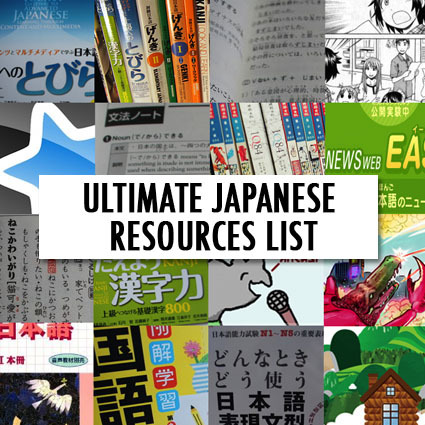
Symbol Guide:
✅All levels 🛠Tool ⏫Advanced 📚Textbook 🔼Intermediate 🗞️Newspaper ⬇️Beginner 🖥️Website ⏬Absolute Beginner 🎮Interactive/Game 📱Mobile Application

HIRAGANA & KATAKANA
⏬🛠Hiragana Mnemonics Chart ⏬🛠Giant List of Mnemonics Charts ⏬🛠English to Katakana Converter ⏬🎮Kana Invaders ⏬🎮Realkana ⏬🎮Hiragana Practice ⏬🎮Katakana Practice ⏬🎮Hiragana and Katakana Practice ⏬🖥️Learn Katakana: The Ultimate Guide ⏬🖥️Learn Hiragana and Katakana on YouTube ⏬📱Learn Hiragana and Katakana ⏬📱iKana

KANJI
✅🛠Self-Study Kanji Flashcards ✅🛠Suiren ✅🛠Stroke Order ✅🛠Kanji Radicals and their Meanings ✅🛠 iKanji ✅🛠How to find the Kanji Radical ✅🖥️Kanji Damage ✅🖥️WaniKani ✅🖥️Memrise ✅🖥️Kanji Kentei ✅🖥️The Kanji Map ✅📱Skritter ⏫🖥️4-Kanji Vocabulary (Yojijukugo) 🔼📚Tobira: Gateway to Advanced Japanese ⬇️🖥️Renshuu ⬇️🖥️Nimonikku ⏬📚Kanji Look and Learn ⏬📚Kodansha Kanji Learning Course

VOCABULARY
✅🛠Language Pal Pack: Questions to Kickstart Conversation ✅🛠Suiren ✅🖥️Memrise ✅🖥️WordReference Forums ✅🎮iKnow! Japanese Core Vocabulary Decks ⏫🖥️4-Kanji Vocabulary (Yojijukugo) 🔼🖥️Japanese Onomatopoeia 🔼🛠Keigo Cheatsheet 🔼📚Tobira: Gateway to Advanced Japanese 🔼📚Common Japanese Collocations 🔼📚Speed Master Series ⬇️🖥️Renshuu ⏬🖥️6000 most used words ⏬🖥️1000 Basic Words ⏬📚Elementary School Dictionary

GRAMMAR
✅🛠All Verb Conjugations Cheatsheet ✅🖥️Tatoeba ✅🖥️JGram ✅🖥️MaggieSensei ✅🖥️Bunpro ✅📚Dictionary of Japanese Grammar and Verbs ✅📚Donna Toki, Dou Tsukau ⏫📚A Dictionary of Advanced Japanese Grammar ⏫📚Nihongo Bunkei Jiten 🔼📚A Dictionary of Intermediate Japanese Grammar 🔼📚Tobira: Gateway to Advanced Japanese ⬇️📚A Dictionary of Basic Japanese Grammar ⬇️🖥️Nihongo Resources ⬇️🖥️Renshuu ⏬🖥️TaeKim’s Guide to Japanese ⏬🖥️Learn Japanese with Erin ⏬📚All about Particles ⏬📚Genki Series ⏬📚Japanese from Zero

READING
✅🛠Japanese.io ✅🛠Read More Or Die ✅🛠Text Analysis ✅🛠Tenjin Reader ✅🖥️Satori Reader ✅🖥️Reajer ⏫🗞️NHK News ⏫🗞️Yomiuri Newspaper ⏫🗞️Nikkan Gendai ⏫🖥️ Read Manga Online 🔼🗞️High School Newspaper 🔼🗞️Kodomo Asahi (Kid’s Asahi News) 🔼🖥️Japanese Subreddits 🔼🖥️The Great ChokoChoko Library ⬇️🖥️Japanese Reading Practice For Beginners ⬇️🖥️Real World Japanese ⬇️🗞️NHK Easy News ⬇️🗞️NHK Easier

WRITING
✅🖥️Lang 8 ✅🛠All Verb Conjugations Cheatsheet ✅🛠How to write on Japanese essay paper (Genkouyoushi) ✅🛠Japanese Journal Writing Beginners to Advanced ⏫🛠Phrases for report writing

LISTENING
✅🛠Language Pal Pack: Questions to Kickstart Conversation ✅🖥️RhinoSpike ✅🖥️NHK WORLD TV ✅🖥️Documentaries About Japan You Can Watch For Free ✅🖥️Top 5 Japanese Dramas ⏫🛠Japanese Audiobooks List ⏫🛠Japanese Audiobooks 2 ⏫🖥️Bilingual News 🔼🖥️TBS News 🔼🛠Japanese Drama Subtitles 🔼🛠Japanese Drama Subtitles 2 ⬇️🗞️NHK Easy News ⬇️🗞️NHK Easier ⬇️🖥️Learn Japanese Pod ⬇️🖥️Erin’s Challenge! ⬇️🖥️Nihongo de Kurasou

SPEAKING
✅🛠Language Pal Pack: Questions to Kickstart Conversation ✅🖥️Make Language Pals ✅🖥️RhinoSpike ✅📱HelloTalk ✅🎮Rosetta Stone Japanese ✅📚Japanese Accent Dictionary ✅🛠Japanese Accent Guide

DICTIONARIES/TRANSLATION TOOLS
✅🛠Kotobank ✅🛠Tangorin ✅🛠Weblio ✅🛠Jisho.org ✅🛠ALC ✅🛠Ninjal-LWP ✅🛠WWWJDIC ✅📚Dictionary of Japanese Grammar and Verbs ✅📚Japanese Accent Dictionary ⏫📚A Dictionary of Advanced Japanese Grammar 🔼📚A Dictionary of Intermediate Japanese Grammar ⬇️📚A Dictionary of Basic Japanese Grammar ⏬📚Elementary School Dictionary ⏬📚All about Particles

JLPT
✅🖥️JLPT Website ✅🖥️TANOS ✅🖥️JLPT Study Plan ✅🖥️Last Minute Resources ✅🖥️Sample Practice Tests ✅📚Nihongo So Matome ✅📚Donna Toki, Dou Tsukau ✅📚New Kanzen Master 🔼📚Speed Master Series

SOFTWARE & APPS
✅📱Anki SRS ✅📱Japanese ✅📱HelloTalk ✅📱Skritter ✅🛠Rikaichan (Firefox) ✅🛠Rikaikun (Chrome) ✅🛠 iKanji ✅🎮Rosetta Stone Japanese

TEXTBOOKS
✅📚Nihongo So Matome ✅📚Donna Toki, Dou Tsukau ✅📚Dictionary of Japanese Grammar and Verbs ✅📚New Kanzen Master ⏫📚A Dictionary of Advanced Japanese Grammar ⏫📚Nihongo Bunkei Jiten 🔼📚A Dictionary of Intermediate Japanese Grammar 🔼📚Tobira: Gateway to Advanced Japanese ⬇️📚A Dictionary of Basic Japanese Grammar ⏬📚Elementary School Dictionary ⏬📚All about Particles ⏬📚Genki Series ⏬📚Japanese from Zero
More resources available here.
13K notes
·
View notes
Text
やばい Alternatives | Vocab
Step 1 of 「伝える力」 が伸びる! 12歳までに知っておきたい語彙力図鑑 focuses on teaching you synonyms for words you would typically use to describe your emotions. There are synonyms for words like やばい, エモい, and the like. This particular post will focus on the information that they've given about やばい。
The book also ranks the words' difficulty level, with 1 star being an "of course you know this" to 5 stars being "even adults probably don't know this and you're about to blow them away with your vocabulary and make them pull out their dictionary." Because of this, you may see words that you encountered quickly as a Japanese learner (that a native speaker 12 year old may not have encountered yet) and vice versa on the list below.


やばい
Because やばい is a word that can be used to express nearly any emotion (much like how OMG can be used in many contexts in American English), the book did also make sure to put the contexts in which the alternative word would be appropriate.
危うい (あやうい)- dangerous; in danger; facing imminent danger ❖This is to be used when dangerous situations are imminent. The way they described it was "危険が迫っている状態" ▶︎Their example: 危うい所でピンチを脱出した。
危険 (きけん)- dangerous; risky; uncertain; precarious; in danger ❖This is to be used when a situation may lead to not-so-good/dangerous outcomes. ▶︎Their example: そんなに高い所からジャンプしたら、危険だよ。
驚異的 (きょういてき)- wonderful; astounding; marvelous ❖This is to be used when something passes a level of surprise that you can express. ▶︎Their example: 大谷選手の達成した記録は驚異的だ。
最高 (さいこう)- best; supreme; wonderful; highest; maximum; supreme ❖This is to be used when describing something of the highest status/dignity/ranking. (This is relative in comparison to other things.) ▶︎Their example: 夏休みに友達と見に行った映画が、最高に面白かった。
素晴らしい (すばらしい)- wonderful; splendid; magnificent ❖ This is used to describe something that's elegant/praiseworthy/splendid, things that are desirable, and things that admirable. ▶︎Their example: 富士山の山頂から眺める景色は、息をのむほどに素晴らしい。
Yojijukugo (四字熟語)
This section also includes four-character compound idioms (yojijukugo) that can be associated with the word we're focusing on expanding our vocabulary from.
絶体絶命 (ぜったいぜつめい)- desperate situation with no escape; being driven into a corner; being cornered; last extremity ❖ You would use this when you find yourself in a situation that there's no conceivable way you could think of making it out in the way that you truly desire. ▶︎Apparently you can use it in phrases like this 「絶体絶命のピンチ」 BONUS: I found an example online that also uses it to mean "stalemate" and the example is a cop and a suspect both pointing a gun at each other.
最上無二 (さいじょうむに)- there is nothing else like it in this world; it's an unparalleled marvel ❖They listed this one at 5 stars (aka, the adults are gonna be surprised that you know this and also go look it up) and I can certainly see why--I couldn't find any official English translations of it. Here's the definition the book gave: この世に二つとなく、最もすばらしいこと。「最上」は最もすぐれていること、「無二」は同じ物がないことを意味するよ。
SOMEONE PLEASE CORRECT ME IF MY UNDERSTANDING OF THIS LAST YOJIJUKUGO IS INCORRECT SO THAT I CAN LEARN IT PROPERLY!! I BESEECH THEE!! I IMPLORE YOU!!
Anyways, the next post will be alternatives words for かわいい and エグい
106 notes
·
View notes
Text

後 - за, позади, после
ключи: 彳(идти 行) + 幺 (нить) + 夂 (нога)
мнемоническое правило: нитка прицепилась к ноге и тащится позади идущего человека
чтения: on ゴ, コウ kun のち, うし, あと, おく
слова:
午後 (ごご) - время после полудня; вечер 最後 (さいご) - последний 後輩 (こうはい) - кохай 後ろ (うしろ) - зад; позади 後で (あとで) - после; потом 以後 (いご) - с этого момента; начиная с 明後日 (あさって) - послезавтра 後悔 (こうかい) - сожаление
0 notes
Text

校 - школа
ключи: 木 (дерево) + 交 (смешение, обмен, соединение)
мнемоническое правило: в древнекитайской деревне все собираются под большим деревом, чтобы обмениваться знаниями - это у них такая школа
чтения: on コウ
слова:
学校 (がっこう) - школа 高校 (こうこう) - старшая школа 校長 (こうちょう) - директор школы; ректор 母校 (ぼこう) - альма матер
0 notes
Text
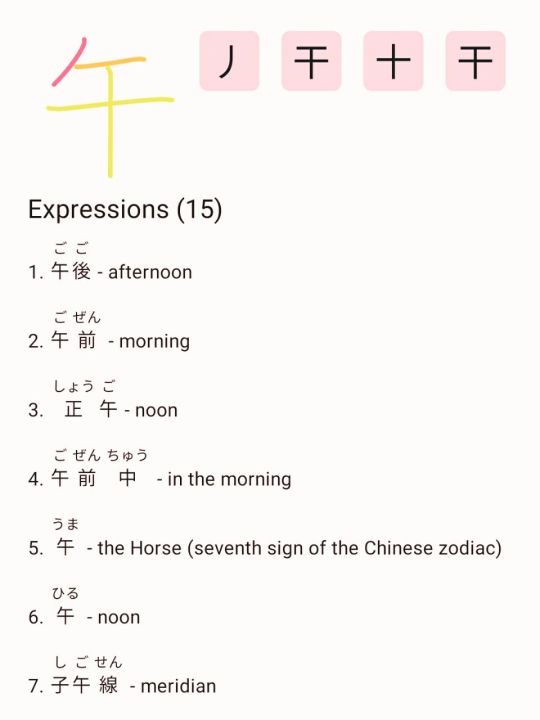
午 - полдень
ключи: 丿(откидная влево) + 干 (сухой; сушильная рама)
мнемоническое правило: носок 丿на сушилке 干 высохнет к полудню
чтения: on ゴ kun うま
слова:
午前 (ごぜん) - время до полудня; утро 午後 (ごご) - время после полудня; вечер 牛 (うま) - "лошадь" (7й знак китайского зодиака)
0 notes
Text
how to play pokemon games to study japanese
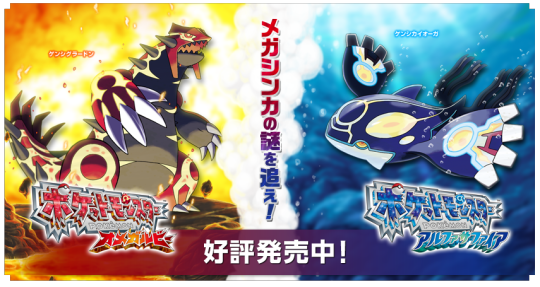
I just started playing pokemon omega ruby in japanese and have been having a great time with it! The language has been surprisingly simple so far, and I've found it a lot easier to get into than animal crossing. I used a few different resources, so here's a guide on how you can play pokemon in Japanese for language learning:
Choosing a pokemon game
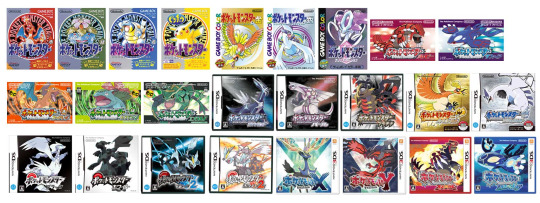
I used this video from gamegengo to decide which game to play and ended up with omega ruby. The tldr of his video is choosing a game that you have access to (in Japanese), that's easy to read (graphics quality makes a huge difference for japanese characters), that's in level. He documented his findings here
Access: Emulators, especially on the PC, are great options for older games. This is especially true for games that are region-locked and need a specific Japanese version to play the game in Japanese. Multi-language support wasn't added until pokemon x/y, so anything older needs a JP version game
Readability: characters on switch games look great, 3DS is also very good. DS is good, anything older can be a bit of a challenge
Hiragana, Kanji, Furigana: prior to pokemon black and white, all text was in hiragana. This can be really challenging if you're used to seeing text with kanji, it can make words much harder to recognize. However, furigana has only been added in arceus and scarlet/violet
Level: All of the pokemon games rank between N3 to N2 except for arceus, which is N2 to N1. I am studying for N3 and am not having much trouble with omega ruby, although I am slow at reading and this is one of the easiest rated games. Someone who is a complete beginner would struggle a lot with these games depending on the amount of reading they intend to do (you don't really need to read to be able to play pokemon)
2. Game resources
There are a variety of resources to help make playing video games in japanese easier. Normally, I would like to just play the game and absorb the content without having to look up a lot of it. Unfortunately, since most pokemon games don't include furigana and aren't voice acted, there is no way to learn how to read a word with kanji you don't know other than to look it up.
Poke Corpus: amazing tool for querying text dumps from different pokemon games. Select the game you're playing and the language, and then write a query with some of the text from a sentence you want to look up. Works great, keep in mind the search is exact (including spacing). It also shows results from other languages, so in addition to pulling all the text for lookup you can see the english translation (which is localized, so is not always a direct translation)
Yomitan: a japanese pop-up dictionary browser extension. Very helpful if you ever read japanese on a computer. I used this video for getting it set up. Very customizable with different dictionaries
Game2Text (PC only): if you're playing a game on an emulator on your computer, this is a great tool for grabbing the text straight from the game. Additionally, since this works inside a browser, any browser extensions (like yomitan) work with this.
Google translate lens: I really don't like this, because it isn't going to be as accurate and it won't show you individual word translations, it will just blur out and translate the entire sentence. But works in a pinch
86 notes
·
View notes
Text
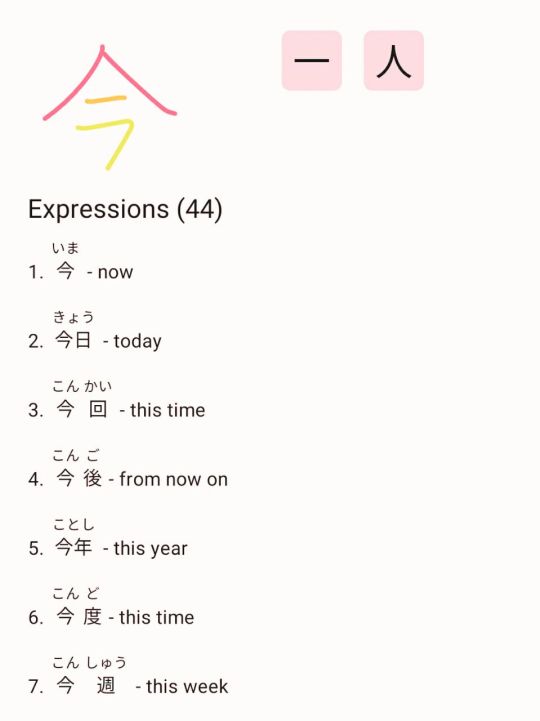
今 - сейчас
ключи: 今 (сейчас)
мнемоническое правило: визуально похож на настенные часы с маятником, которые показывают, сколько сейчас времени (©ejable)
чтения: on コン、キン kun いま
слова:
今日 (きょう) - сегодня 今月 (こんげつ) - текущий месяц 今年 (ことし) - текущий год 今夜 (こんや) - сегодня вечером 今朝 (けさ) - сегодня утром 今回 (こんかい) - (в) этот раз 今度 (こんど) - (в) следующий раз
0 notes
Text
one of my students shared this cool website where you can drill yourself on japanese conjugations: link
i looked at it myself and you can mess with options to choose if you want verbs, adjectives, which conjugations you want to practice, if you want furigana, etc. there's a bunch of stuff
596 notes
·
View notes
Text
Basic quantifiers in Japanese
台 (だい) - used for cars, bicycles, machines, mechanical devices, household appliances
杯 (はい) - used for cups and glasses
匹 (ひき) - used for small animals
本 (ほん) - used for long and thin objects
階 (かい) - used for floors
回 (かい) - used for occurrences, numer of times
個 (こ) - used for things that are small and round
枚 (まい) - used for thin and flat objects
人 (にん) - used for people (but we say 一人 (ひとり) for one person and 二人(ふたり)for two
冊 (さつ) - used for books
歳 (さい) - used for age
Plus general quantifiers:
一つ (ひとつ)
二つ (ふたつ)
三つ (みっつ)
四つ (よっつ)
五つ (いつつ)
六つ (むっつ)
七つ (ななつ)
八つ (やっつ)
九つ (ここのつ)
十 (とお)
926 notes
·
View notes
Note
hello there! i would like to ask if you know any sites where i can practice reading japanese? like news sites, manga sites, or sites that offer free e-books that are in japanese. and are there any japanese podcasts that i can listen to? thank you in advance for answering this question. it'd mean a whole to me!
Hey there! There are actually quite a few recommended sites for Japanese learners, so I’ll link them right now :)
Japanese IO – I’ve used this site quite a few times and I love the interface! The design is really sleek and “to the point,” so there’s no distractions from what you’re trying to do, which is practice reading Japanese. It also has a great library and look-up feature.
朝日学生新聞社 – This is the “kid’s version” of the more adult 朝日新聞社. If you don’t feel that you’re quite up for the adult version, test out the version geared towards kids. They have fewer articles, but there’s plenty for a learner to pick through.
NHK NEWS EASY – I’m almost positive this is one of the most famous ones for learners. It’s similar to Asahi’s kid newspaper – articles are condensed with easier kanji and vocabulary, and it’s geared towards children, so learners can spend some time combing through updated articles and testing their skills.
Yahoo! Kids – More short news articles geared towards easier-to-understand Japanese.
MATCHA – A fun magazine similar in style to NHK EZ.
Watanoc – Another magazine-type site with a variety of articles.
Traditional Japanese Stories – Get your hands on some easily printed Japanese stories that are told to children. Great for language skills and culture! Similar to English pop culture stories (like Cinderella and so on), Japan has its own fairytales that are occasionally referenced.
Fuku Musume’s Fairy Tale Collection – More stories!
World of チョコチョコ – These are beginner stories, but as you progress you can read other stories on this website.
EhonNavi – Read hundreds of Japanese picture books for free!
If you’re looking for more advanced content…
NHK – Japan’s national broadcaster. You can read articles as well as stream audio and video (may be blocked depending on location).
毎日新聞 – Moderate/left-leaning national newspaper
朝日新聞 – Left-leaning national newspaper
読売新聞 – Conservative national newspaper
東洋経済オンライン – A well-known business and finance magazine.
Project Gutenberg (Japanese) – Get access to a ton of out-of-print and classical books for free.
小説家になろう – A site where authors can publish their works online in exchange for reviews.
青空文庫 – Another site where you can get older and out-of-print novels.
University of Virginia Japanese Text Initiative – Another place to access novels in Japanese for free (with the option to read them with furigana).
ComicWalker – Free manga from the publisher Kadokawa. There’s an app too!
最前線 – You can read some manga online for free.
コミコ – More free Japanese manga available here!
キナリノ – A woman’s lifestyle blog which covers fashion, cooking, decor, and more!
Magazine Lib – You can read PDFs of Japanese magazines.
1000文字小説 – A place where users can submit 1000 characters or less stories.
I also highly recommend starting a Twitter (if you don’t already have one) and following Japanese accounts. I follow a lot of feminist and political accounts so that I’m learning words relevant to my interests, as well as interacting with people that are discussing topics of interest to me (i.e. women and their place in Japanese society).
If you’re curious, you can find me on Twitter at @sydney0313 :)
I hope this list proves useful to you! (And others.)
頑張ってください!
6K notes
·
View notes
Note
as a japanese learner, im curious what the experience of memorizing all the different ways to read the same kanji is for a native speaker ? im currently learning about all the different ways to count things and ive never had to take so many notes about anything in my entire life lmao, its hard but its also fun
First of all, I'm glad to hear that you are enjoying learning Japanese! 😆 The Japanese way of counting things is obviously very hard to remember! It's often cited by Japanese people as a typical example of the unreasonableness of the Japanese language: When counting long objects such as sticks or rope, the particle "本(hon)" is used, but when written in kanji, it will be like "一本(1)," "二本(2)," "三本(3)", but they are read as "ippon," "nihon," and "sanbon," respectively. Even though they all use the same kanji! 😅 (This is probably what you're studying, right?) Even native speakers cannot explain this regularity, but I'd be happy if you found this kind of unreason interesting. :)
Regarding the question of what kind of experience it is for native speakers to learn different readings of the same kanji, I think native speakers often know the word by sound first, and later understand that "Ah, this kanji is used for this word. This may be something that can only be experienced through the listening of Japanese many times.
Also, although you may already know this information, it is actually possible to guess the reading of kanji by guessing.
For example, in the case of the kanji "枝(eda)" used in Nagito's surname:
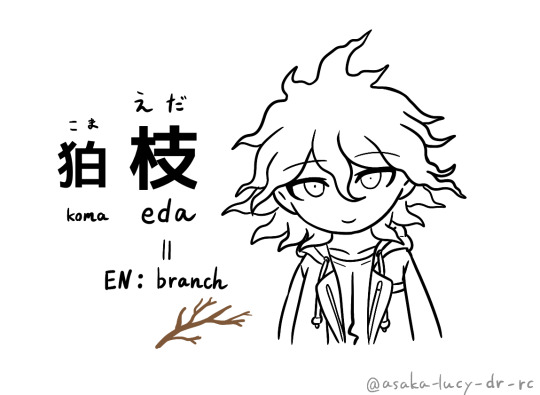
In some cases, this is read as "shi" in some kanji compounds. For example, "枝(eda)" can be combined with the kanji "葉(ha)" in Yasuhiro's surname.
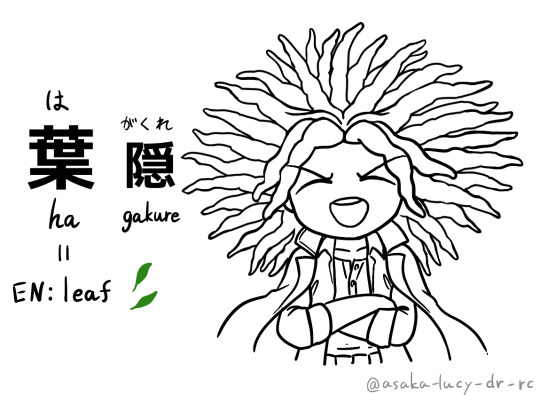
If you combine the kanji "枝(eda)" and "葉(ha)", it will be "枝葉(shiyo / shiyou)". The word "枝(eda)" means "branch" and "葉(ha)" means "leaf," but when both are combined to form the word "枝葉(shiyo)," it means "non-major or non-essential things.
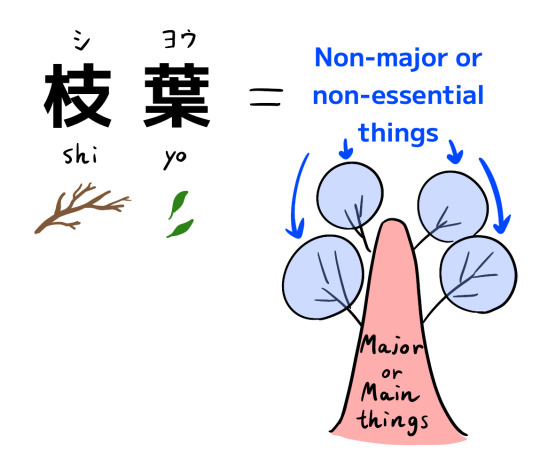
I think the reading "葉(yo)" is unfortunately reading you have to memorise it, but as for "枝(shi)", it's a reading that can be guessed. This is because the kanji "支", one of the parts used in the kanji "枝(eda)", is read as "shi".

For On reading* of kanji, the reading of the parts composing the kanji is often used in this way. If native speakers encounter a kanji they do not know how to read, they use this rule to predict the reading. (*Kanji has two general readings: Kun reading and On reading. In the case of "枝", "eda" is Kun reading and "shi" is On reading.)
For example, a slightly more difficult kanji than "枝" is "肢," which is also read as "shi". This is a kanji means the branched parts of the body, mostly the limbs.

Thus, as long as you learn the basic kanji that are used as parts of other kanji, you will be able to read them by guessing rather than by memorizing them. 😄
You may already know or be aware of this: "支" means something that is branched. A similar example is the kanji "岐", which means "forked road".
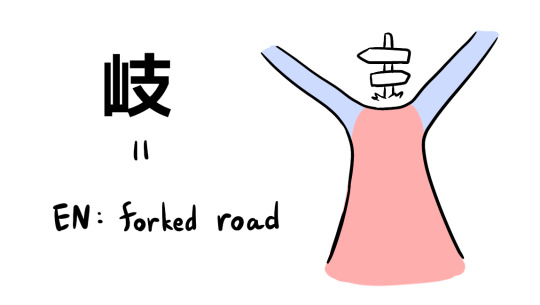
Now, after reading all of this, you might think: "Wow, kanji is very easy to understand! And the reading of this kanji must also be "shi"! 😄
...Unfortunately, it is not that easy, and that is the complication with Kanji. Actually, the kanji "岐" is read as "ki".
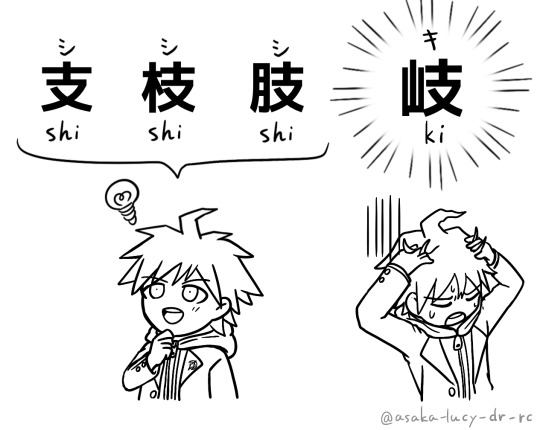
Native Japanese speakers often fall into this trap as well! 😅
In most cases, the only way to read kanji correctly is to memorize it, but if we don't know it, we try to guess the reading from the parts. But this is just a matter of luck, and it often fails. 😭
However, as I showed earlier in the picture, kanji is something that can already convey meaning by its shape. So even native speakers often encounter kanji that they are not sure how to read, but they may guess that it probably means something like this from the parts and ignore what the reading is.
Even between native speakers, the other person may be speaking with an incorrect reading, but it can also be guessed by imagining the parts used for the kanji. For example, there is a kanji compound "分岐" that is correctly read as "bunki," but suppose the person I am talking to reads it as "bunshi. Even in such a case, I can think that the person probably thought it was "分岐" because the character for "岐" has a kanji part "支," so the person read it as "bunshi. (Most of the time I will point out the misreading to the person, but sometimes I will just ignore it because I can understand what they were trying to tell me.)
The same is true for the same kanji with different readings. For example, the kanji compound "枝葉(shiyo)" introduced earlier can actually be read as "edaha," but in that case it simply means tree branches and leaves. So it is one of those kanji compounds that uses the same kanji but has a different meaning when read differently. But even if you didn't know that it should be read as "shiyo," I don't think you'd have much trouble, because I think you'd be able to understand the meaning of the sentence in which that compound is used based on the image of the kanji.
In conclusion, even for native speakers, it is difficult to memorize how to read each kanji. In most cases, we know at least one basic reading for basic kanji, but rarely do we know all the other different readings. So we often try to read it somehow by guessing from the parts the kanji uses. And as a result, we often get it wrong. 😅 But I think we can guess what they are trying to say from different aspects of each other, so I don't think we care too much.
Hmmm. I think Japanese is a pretty lax language, but maybe the Japanese are lax too! My explanation has gone off on many tangents, but I hope you continue to enjoy learning Japanese. 💖
154 notes
·
View notes
Text
絡める
からめる
① to entwine; to twine around; to mix together
② to coordinate (with)
③ to arrest (搦める)
生卵を絡めるとまろやかな口当たりで更に美味しい! なま たまご を からめる と まろやか な くちあたり で さら に おいしい! Mixing in a raw egg with its mild taste makes it even more delicious!

25 notes
·
View notes
Text
When you get to big numbers, the Japanese counting system starts to differ from English. I am not a numbers person, so when I have numbers in my work, I double check constantly. Usually I use on SLJ FAQ, but today I used Jisho and I found this interesting hiccup.

The second suggestion is fine! 2000万 [にせんまん] does mean 20,000,000. It does NOT, however, mean 平成12年 [へいせいじゅうにねん], or the year 2000. (More about the years thing here.)
To get into it, 万 means 10,000. It's usually read マン or バン, but sometimes it's よろず. We've covered its archaic form 萬, and you probably know the exclamation 万歳 banzai. It literally means eternal life and prosperity, but in practical use, it means "Hooray!," to cheer, or the gesture of throwing one's hands up (in either celebration or defeat... or, you know, on a roller coaster or whatever).
But as a number, it also happens to be where the counting system starts to change. Let me borrow a graphic:
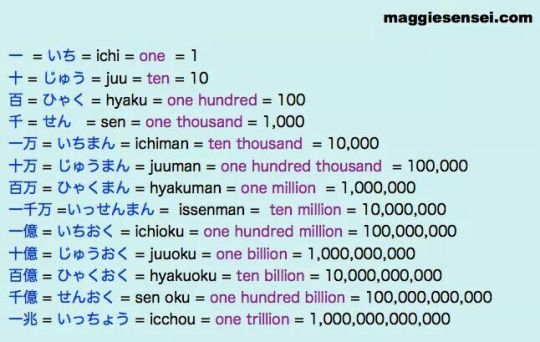
Yuck. Maybe you're saying, "Well, these are big numbers, I'm not gonna encounter them that often," I am very sorry to tell you that the yen is counted in CENTS, so if something costs $10, its price is four figures. And with current exchange rates, 10K comes into play around the $66 mark. So you have to learn the big numbers, even if you hate it! Sorry!
222 notes
·
View notes
Text
JLPT N2 文法・もの
In this post let's look at various N2 grammar points involving もの.
★ものなら★

if I/we could; if A is possible, then B; if one can do something, then ~
This grammar structure implies that the task is either impossible or very unlikely.
Verb (れる form) + ものなら Verb (れる form) + もんなら (spoken)
例文
帰れるものなら、今すぐ、国へ帰りたい。 If I could, I'd like to go back to my country right now.
やれるもんなら、やってみろ。 If you can do it, then let's see you try.
★ものだから★
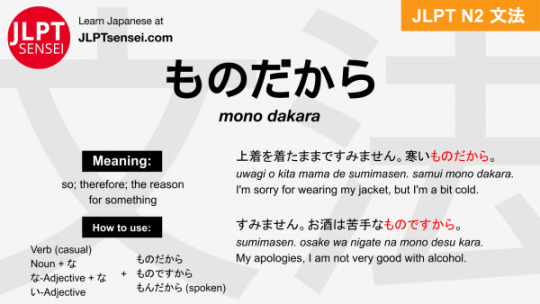
so; therefore; the reason for something
This is often used when telling an excuse or declining an invitation.
Verb (casual) + ものだから・ものですから・もんだから (spoken) Noun + な + ものだから・ものですから・もんだから (spoken) な-Adjective + な + ものだから・ものですから・もんだから (spoken) い-Adjective + ものだから・ものですから・もんだから (spoken)
例文
すみません、風邪を引いてしまったものですから、今日は欠席です。 I'm sorry, I caught a cold and so I will be absent today.
私の変わりにこれをしていただけませんか。私は大変に忙しいものですから。 Could you please do this on my behalf? Because I am too busy to do it myself.
★もの★
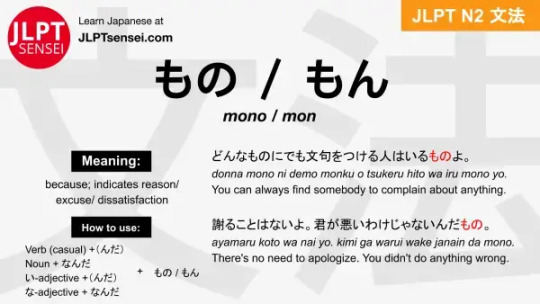
because; indicates reason/excuse/dissatisfaction
This is used to express a reason to justify something.
例文
私何も話すことなんかありませんよ。だって何も知らないんですもの。 I have nothing to say. I mean, I don't even know anything.
謝ることはないよ。君が悪いわけじゃないんだもの。 There's no need to apologize. You didn't even do anything wrong.
★ものの★

but; although; even though ~
Verb (casual) + ものの Noun + である + ものの い-adjective + ものの な-adjective + な + ものの
例文
私のアパートは駅からはちょっと遠いものの、静かできれいな住宅街にある。 My apartment may be far from the station, but it is in a very quiet and beautiful neighborhood.
秋であるものの、まだ暑い。 Although it's fall, it is still hot.
75 notes
·
View notes
